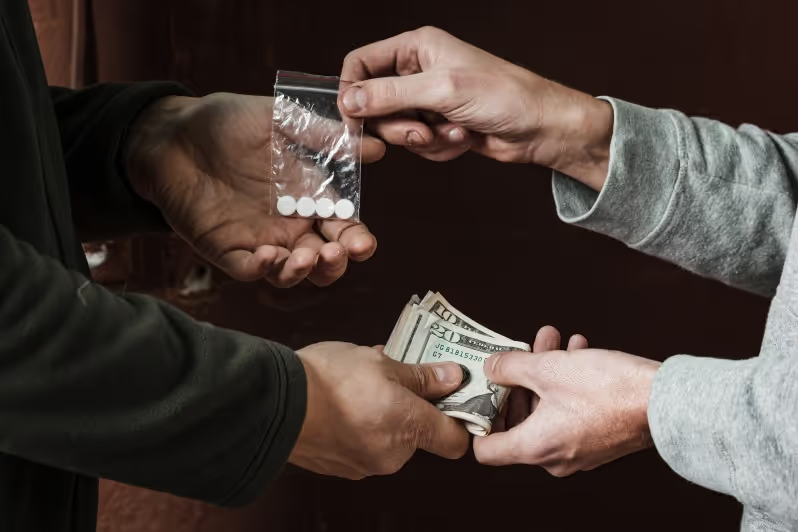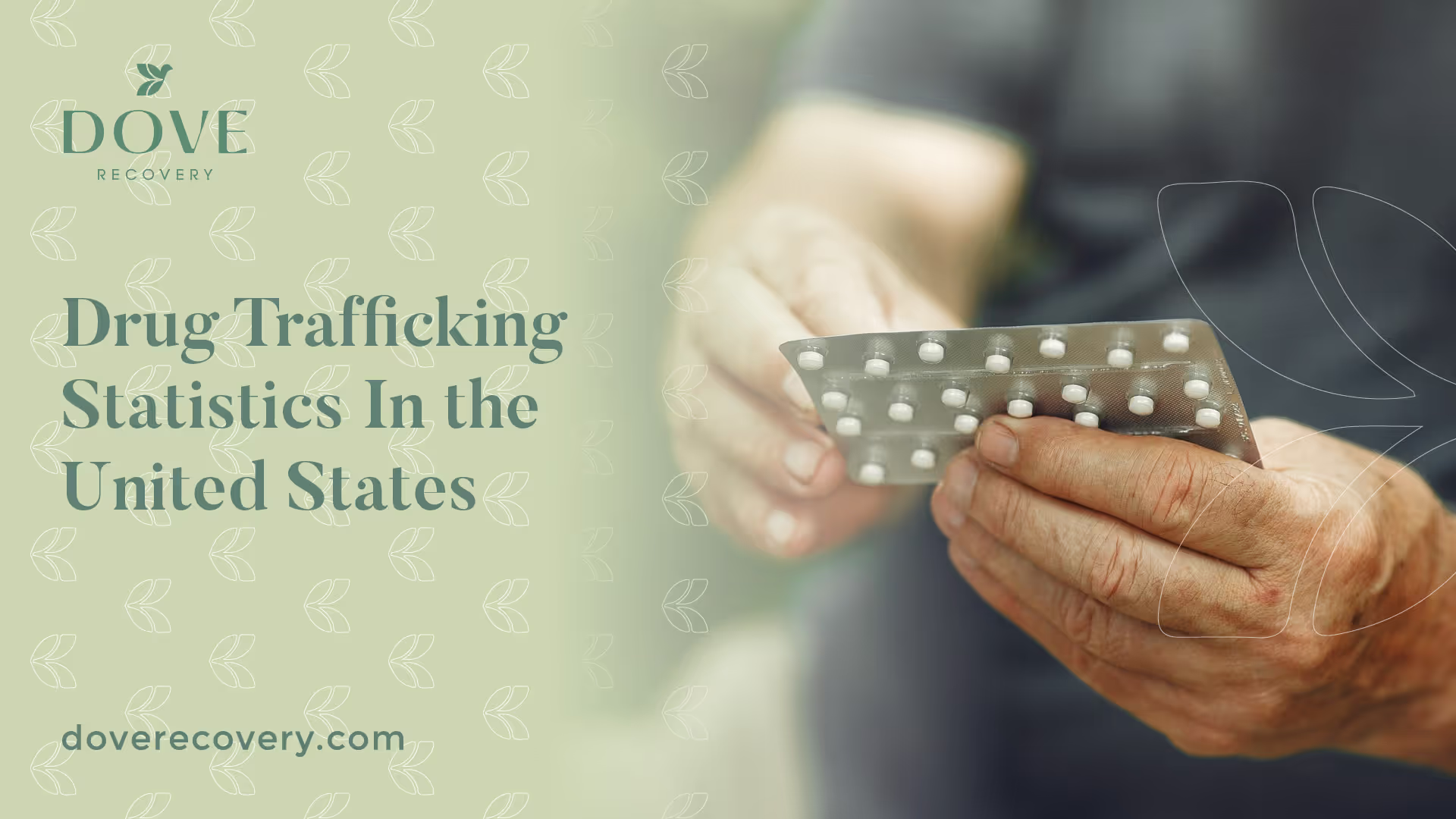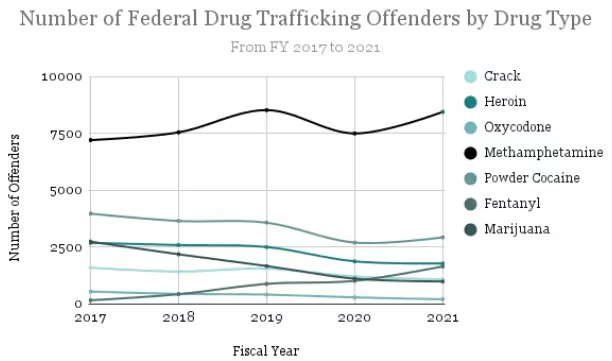Drug Trafficking Statistics In the United States


How Common Is Drug Trafficking?
Drug trafficking is a significant and complex criminal activity in the United States that involves the production, distribution, and sale of illegal drugs.
In recent years, drug trafficking has become a major concern for law enforcement agencies due to its widespread impact on American society.
According to recent drug trafficking statistics, approximately 61.2 million Americans aged 12 and older used illicit drugs in 2021, highlighting the need for effective strategies to combat drug trafficking and substance abuse.
Addressing this issue requires a multi-faceted approach that involves law enforcement efforts, public education, and access to treatment programs for those struggling with addiction.
Key Drug Trafficking Statistics
- According to the Drug Enforcement Administration (DEA), drug trafficking organizations are responsible for bringing large quantities of illegal drugs into the U.S. every year. These organizations are often highly organized and use sophisticated methods to evade law enforcement.
- The DEA reports that Mexican drug trafficking organizations are the primary suppliers of illegal drugs in the U.S. These organizations are responsible for trafficking large amounts of marijuana, cocaine, methamphetamine, and heroin into the country.
- The National Institute on Drug Abuse (NIDA) reports that drug overdoses are a leading cause of injury and death in the U.S. In 2019, more than 70,000 people died from drug overdoses, with opioids being the most deadly type of drug.
- The Centers for Disease Control and Prevention (CDC) reports that drug overdose deaths involving synthetic opioids (such as fentanyl) increased by 38.4% from 2018 to 2019.
- The DEA reports that drug trafficking organizations are increasingly using the internet to sell drugs, often using anonymous online marketplaces and cryptocurrencies to evade law enforcement.
- The Substance Abuse and Mental Health Services Administration (SAMHSA) reports that more than 20 million people in the U.S. over the age of 12 have a substance use disorder.
- The National Survey on Drug Use and Health (NSDUH) reports that marijuana is the most commonly used illicit drug in the U.S., with 43.5 million people (or 15.5% of the population) using it in the past year.
- In 2019, the DEA seized more than 2.5 million pounds of illegal drugs in the U.S.
- The NIDA reports that substance use disorders cost the U.S. economy more than $600 billion each year in healthcare costs, lost productivity, and crime.
- The CDC reports that drug overdose deaths involving cocaine increased by 26.5% from 2018 to 2019.
- The NSDUH reports that approximately 1 in 13 people who use marijuana will become addicted to it.
- The SAMHSA reports that more than 1 million people in the U.S. received treatment for a substance use disorder in a specialized facility in 2019.
- In 2020, the DEA seized more than 5,400 pounds of methamphetamine, which represents a 13.9% increase from the previous year.
- The DEA also seized more than 2,200 pounds of fentanyl in 2020, an increase of over 300% from the previous year.
- Despite decreases in cocaine-related overdose deaths from 2018 to 2019, cocaine remains a significant drug trafficking concern. The DEA seized more than 32,000 pounds of cocaine in 2020.
- Prescription drugs continue to be a target for drug traffickers. The DEA reports that prescription drugs accounted for approximately one-third of all drug seizures in the U.S. in recent years.
- Drug trafficking organizations are increasingly using social media platforms such as Facebook and Instagram to sell drugs and recruit new members. The DEA has identified several cases where individuals have used these platforms to facilitate drug transactions.
6 Drug Types Accounted for Drug Trafficking Offenses
Drug trafficking offenses in the U.S. cover a wide range of activities related to the production, distribution, and sale of controlled substances.
The following drugs accounted for nearly all drug trafficking offenses in the U.S. in 2020:
- Methamphetamine increased 13.9%
- Crack Cocaine decreased 22.8%
- Powder Cocaine decreased 30.3%
- Heroin decreased 33.2%
- Fentanyl increased 1,946.0%
- Oxycodone decreased 47.5%
- Marijuana decreased 67.3%
Mexican drug trafficking organizations are the primary suppliers of these illicit drugs in the U.S., and they use sophisticated methods to smuggle large amounts of drugs into the country.

Despite law enforcement efforts to curb drug trafficking, these organizations continue to find new ways to evade detection and bring drugs into the country. The abuse of these illicit drugs has led to an increase in drug-related deaths and a public health crisis.
Opioids are responsible for most drug overdose deaths in the U.S., with more than 70,000 people dying from overdoses in 2019 alone.
In addition to overdose deaths, substance abuse also leads to other negative outcomes such as addiction, crime, and lost productivity. Addressing drug trafficking is an essential component of reducing substance abuse and mitigating the harm caused by these dangerous substances.
The Top 5 Districts for Drug Trafficking
The U.S. Department of Justice has identified five major drug trafficking hubs in the U.S., which are as follows:
The Southern District of California
This district is known for its proximity to the U.S.-Mexico border and its location along major transportation routes. It is considered a significant transit point for drugs smuggled into the U.S. from Mexico and other countries.
The Western District of Texas
This district covers a large area along the Texas-Mexico border and is known for its high levels of drug trafficking activity. In 2020, U.S. Customs and Border Protection seized over 2,000 pounds of methamphetamine and over 1,000 pounds of cocaine in this district alone.
The Southern District of Texas
This district is another key transit point for drugs smuggled into the U.S. from Mexico. In 2020, U.S. Customs and Border Protection seized over 4,000 pounds of methamphetamine and over 1,500 pounds of cocaine in this district.
The District of Arizona
This district covers much of the Arizona-Mexico border and is considered a significant hub for drug trafficking activities. In 2020, U.S. Customs and Border Protection seized over 3,000 pounds of methamphetamine and almost 1,000 pounds of fentanyl in this district.
The Southern District of Florida
This district covers much of southern Florida and is known for its high levels of drug trafficking activity related to South American drug cartels. In 2020, U.S. Customs and Border Protection seized over 8,000 pounds of cocaine in this district.
These districts are considered significant hubs for drug trafficking due to their proximity to the U.S.-Mexico border and their location along major transportation routes. They are known to be key transit points for drugs smuggled into the U.S. from Mexico and other countries. Law enforcement agencies in these districts work closely with federal authorities to combat drug trafficking activities and disrupt criminal organizations involved in the trade.
Despite efforts by law enforcement agencies to crack down on drug trafficking in these districts, they continue to be significant sources of illegal drugs in the United States.

What are the Adulterated Drugs?
Adulterated drugs are a growing concern in the United States. These are drugs that have been mixed with other substances to increase their weight or potency, often resulting in dangerous side effects for users. Here are some key statistics related to adulterated drugs:
- The DEA reports that fentanyl, a powerful synthetic opioid, is frequently found in counterfeit pills sold on the street. In 2019, the agency seized more than 2 million counterfeit pills containing fentanyl.
- According to a study published in JAMA Network Open, nearly 40% of cocaine-related overdose deaths in New York City involved fentanyl or other synthetic opioids.
- The National Forensic Laboratory Information System (NFLIS) reports that methamphetamine samples seized by law enforcement agencies increasingly contain other substances such as fentanyl and benzodiazepines.
- The Drug Enforcement Administration (DEA) reports that heroin is often mixed with fentanyl to increase its potency. This has led to an increase in overdose deaths involving heroin laced with fentanyl.
- The Centers for Disease Control and Prevention (CDC) reports that between 2017 and 2018, there was a significant increase in the number of drug overdose deaths involving cocaine and synthetic opioids.
These statistics highlight the danger posed by adulterated drugs and underscore the need for increased efforts to combat drug trafficking and ensure that drugs sold on the street are safe for use. Law enforcement agencies must remain vigilant in their efforts to identify and intercept adulterated drugs before they reach consumers, while public health officials must work to educate individuals about the risks associated with drug use.
Drug Trafficking Prevalence
Drug trafficking is a widespread problem that affects communities throughout the United States. Despite the best efforts of law enforcement agencies, drug trafficking remains prevalent in many areas of the country.
Drug trafficking organizations use sophisticated methods to smuggle drugs into the U.S., and they often rely on violence and intimidation to maintain control over their territories. The prevalence of drug trafficking has led to an increase in substance abuse and addiction in many communities.
The availability of illicit drugs has made it easier for individuals to become addicted, leading to a rise in overdose deaths and other negative outcomes.
- Addressing drug trafficking requires a comprehensive approach that involves both law enforcement efforts and public health initiatives.
- Law enforcement agencies must continue to work to disrupt drug trafficking organizations and prevent drugs from entering the country.
- Public health programs must focus on preventing substance abuse and providing support for those struggling with addiction.
- Reducing drug trafficking will require a sustained effort from all levels of government, as well as cooperation between law enforcement agencies, healthcare providers, and community organizations.
- According to the Centers for Disease Control and Prevention (CDC), more than 93,000 Americans died from drug overdoses in 2020, which represents a record high.
- The economic impact of drug abuse is also significant, with estimates suggesting that it costs the U.S. economy billions of dollars each year in lost productivity, healthcare costs, and criminal justice expenses.
Demographics of Drug Trafficking Offenders
According to the United States Sentencing Commission, the demographics of federal drug trafficking offenders vary widely. Here are some sample statistics from recent years:
- In fiscal year 2019, 24.4% of federal drug trafficking offenders were Hispanic/Latino, while 22.6% were Black/African American and 52.8% were White.
- Among female federal drug trafficking offenders in fiscal year 2019, 33.1% were Hispanic/Latina, while 28.5% were Black/African American and 36.6% were White.
- In fiscal year 2020, the average age of federal drug trafficking offenders was 38 years old.
- Approximately 94% of federal drug trafficking offenders in fiscal year 2020 were male.
- In fiscal year 2020, nearly half (49%) of federal drug trafficking offenders had little or no prior criminal history.
These statistics highlight the diversity of individuals involved in drug trafficking at the federal level and underscore the need for policies that address systemic issues related to substance abuse and addiction in all communities.
What Are the Drug Trafficking Offences?
Drug trafficking offenses in the U.S. refer to a range of activities related to the production, distribution, and sale of controlled substances. These offenses include:
Manufacturing drugs
This involves producing illicit drugs like methamphetamine, cocaine, and heroin. According to the United Nations Office on Drugs and Crime (UNODC), global cocaine production reached an all-time high of 1,976 tons in 2019.
Distributing drugs
This involves transporting drugs from one location to another for sale or distribution. Mexican drug trafficking organizations are the primary suppliers of illegal drugs in the United States, and they use sophisticated methods to smuggle large amounts of drugs across the border.
Selling drugs
This involves exchanging controlled substances for money or other goods. In 2020 alone, U.S. Customs and Border Protection seized more than 26,000 pounds of cocaine and over 4,000 pounds of heroin.
Importing/exporting drugs
This involves bringing drugs into the country from another location or exporting them to another country. The Drug Enforcement Administration (DEA) estimates that Mexican drug trafficking organizations earn between $19 billion and $29 billion annually from drug sales in the United States.
Possession with intent to distribute
This refers to possessing a controlled substance with the intent to sell or distribute it. According to data from the Federal Bureau of Investigation (FBI), there were over 1.5 million drug arrests in the United States in 2020.
Drug trafficking is a serious offense that can result in severe penalties, including lengthy prison sentences and hefty fines. Law enforcement agencies are continually working to disrupt drug trafficking organizations and prevent illegal drugs from entering communities across the country.
Punishment and Average Sentencing for Federal Drug Trafficking Offenders
Here are some sample statistics related to punishment and average sentencing for federal drug trafficking offenders:
- The average sentence for drug trafficking offenders was 76 months but varied by drug type
- In 2020, there were over 45,000 federal drug trafficking cases prosecuted in the U.S.
- Of those cases, nearly 97% resulted in a prison sentence for the offender.
- Over two-thirds of those convicted of a drug trafficking offense were sentenced to a mandatory minimum penalty.
- The severity of the sentence often depends on the quantity and type of drugs involved in the offense. For example, an individual caught with a small amount of marijuana may receive a shorter sentence than someone caught with large quantities of cocaine or heroin.
- Repeat offenders and those with prior criminal records may also face longer sentences than first-time offenders.
- In addition to prison time, individuals convicted of drug trafficking offenses may also be subject to fines, forfeiture of assets, and other penalties.
These statistics highlight the serious consequences that can result from involvement in drug trafficking activities. Law enforcement agencies continue to work tirelessly to disrupt these criminal organizations and prevent illegal drugs from entering communities across the country.
Conclusion
Drug trafficking is a serious problem that continues to plague the United States, with Mexican drug trafficking organizations being the primary suppliers of illegal drugs. Despite law enforcement efforts to disrupt drug trafficking activities and prevent drugs from entering the country, these organizations continue to find new ways to evade detection and bring drugs into communities across the country.
The consequences of substance abuse are severe, with overdose deaths and addiction rates on the rise. Adulterated drugs also pose a significant risk to individuals who use them, highlighting the need for increased efforts to combat drug trafficking and ensure that drugs sold on the street are safe for use.
Addressing drug trafficking requires a comprehensive approach that involves both law enforcement efforts and public health initiatives. By working together, we can reduce substance abuse, mitigate its harmful effects, and create safer communities for all people.
Sources:
- United Nations Office on Drugs and Crime (UNODC)
- https://www.dea.gov/press-releases/2022/12/20/drug-enforcement-administration-announces-seizure-over-379-million-deadly
- Centers for Disease Control and Prevention (CDC)
- National Forensic Laboratory Information System (NFLIS)
- U.S. Customs and Border Protection
- Federal Bureau of Investigation (FBI)
- https://drugabusestatistics.org/drug-related-crime-statistics/
